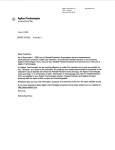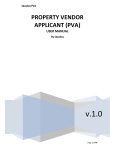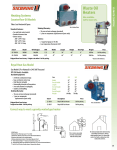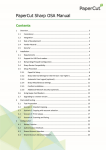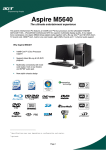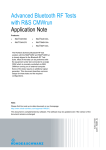Download Network Device, Method of Controlling Network Device, and
Transcript
US 20130132576A1 (19) United States (12) Patent Application Publication (10) Pub. No.: US 2013/0132576 A1 Haba et al. (54) (43) Pub. Date: NETWORK DEVICE, METHOD OF (52) CONTROLLING NETWORK DEVICE, AND May 23, 2013 US. Cl. CPC .... .. G06F 15/17306 (2013.01); H04L 61/2007 RECORDING MEDIUM ON WHICH (2013.01) PROGRAM FOR CONTROLLING NETWORK USPC DEVICE Is RECORDED 71 A licant: Buffalo Inc., Na 0 a-shi JP ( ) pp g y ( ) (72) Inventors: Yoshifumi Haba, Nagoya-shi (JP); Hideki Ishii, Nagoya-shi (JP) (73) Assignee: Buffalo Inc., Nagoya-shi (JP) (21) Appl. No.: 13/677,323 (22) Filed: (30) Nov. 15, 2012 Foreign Application Priority Data Nov. 22, 2011 (JP) ............................... .. 2011-254787 Publication Classi?cation (51) Int. Cl. G06F 15/1 73 (2006.01) 709/225 ........................................................ .. (57) ABSTRACT An access point AP that is an embodiment of a network device assigns an IP address to a terminal connected to the access point AP itself. The access point AP includes: a distributing unit 118 that distributes the IP address to terminal and has functionality to notify the terminal to transmit all access requests to the network deviceAP itself; a distribution control unit 120 for switching the functionality of the distributing unit 118 to be operative on the basis of the generation of a prede termined starting event; an accepting unit 112 for accepting any given access request from the terminal; and a notifying unit 114 for notifying the requesting terminal of information for accessing the network device AP when the accepting unit has accepted the request, regardless of the content of the request. 210 211 Web browser 212 DNS client 213 DHCP client 220 Storage medium 230 240 Display unit 250 Operation unit 260 Patent Application Publication TE May 23, 2013 Sheet 1 0f 12 TE(TE1) TE US 2013/0132576 A1 Patent Application Publication May 23, 2013 Sheet 2 0f 12 US 2013/0132576 A1 Hco_imE\zHo N.UE coEwmrziltpow cnowr:m|>t_nuwga )(omH lkHm lkNMH Patent Application Publication May 23, 2013 Sheet 3 0f 12 0m ) owm) US 2013/0132576 A1 0m ) 0m ) m.@E \oN Patent Application Publication May 23, 2013 Sheet 4 0f 12 US 2013/0132576 A1 FIG. 4 ( < I Connection Setting Process ‘I N 50 10 ls button pressed ? > NO \IYES /\/ 5020 Cutting off an existing connection I N $030 I ITemporary Connection Preparation ProcessI I Connection standby state (changing to an open connection-use ESSID) l, ‘I: I _ /\—-SO5O <Is there a request for wireless connectlon to a virtual port ?>W WES @5070 I I Temporary Connection Setting Process I I /\——SO8O < Is there a DNS request ? I \IYES DNS Disguise Process W /\—$090 I I‘ S100 NO is an IP address requiring accessing via DGW speci?ed ? YES M5110 Responding to designated IP address by feigning transmission origin (impersonating designated destination) S120\/\ \ki <Is there an access request from the designated terminal 7% S130~/-\ II \IYES Setting Process II Connection Recovery Process II S140~/\ II S150~/'\ | Changing back ESSID I’ | Patent Application Publication May 23, 2013 Sheet 5 0f 12 US 2013/0132576 A1 FIG. 5 Gemporary Connection Preparation Proces9 \l/ M5210 Starting DHCP server function 1/ M5220 Starting DNS disguising function i, M5230 Starting IP address disguising function i, b/s240 Starting Web server function Q i ) Patent Application Publication May 23, 2013 Sheet 6 0f 12 US 2013/0132576 A1 FIG. 6 Gemporary Connection Setting Proces9 \ l , M5250 Generating designated terminal-use IP address information i, p/szeo Transmitting the designated terminal-use IP address information i, M5270 Transmitting DNS server information to designated terminal \ I , b/szso Transmitting DGW information to designated terminal Q i ) Patent Application Publication May 23, 2013 Sheet 7 0f 12 US 2013/0132576 A1 FIG. 7 C Connection Recovery Process ) i, M5290 Ending Web server function \I/ M5300 Ending DHCP server function i, M5310 Ending disguising function C i > Patent Application Publication May 23, 2013 Sheet 9 0f 12 US 2013/0132576 A1 FIG. 9 First Setting Information Transmission Process l, M5510 Generating a connection setting ?le based on the present security setting l M5520 Starting transmission of the connection setting file to the designated terminal l, M5530 Changing connection with another wireless terminal to an inhibition state \y /\/ 5540 Has the designated terminal YES completed downloading ? NO< \LNO \|/<YES rd S550 Has the limit time elapsed ? < Return ) Patent Application Publication May 23, 2013 Sheet 10 0f 12 US 2013/0132576 A1 FIG. 10 C D Second Setting Information Transmission Process l M5610 Searching for connection setting-use software corresponding to OS V h/sszo Generating a connection setting ?le based on the present security setting l l M5630 Starting transmission of the connection setting ?le and connection setting-use software to the designated terminal M5640 Changing connection with another wireless terminal to an inhibition state b/seso < % YES Has the designated terminal completed downloading ? \LNO M5660 Has the limit time elapsed ? Return D Patent Application Publication May 23, 2013 Sheet 12 0f 12 US 2013/0132576 A1 FIG. 12 ( Simple Setting Process ) 51000 NO (ls connection to a designated terminal detected ?>— NSOZO I Cutting off an existing connection /VSO3O “Temporary Connection Preparation Process“ $1050 l< ls there a request for connection to a virtual port ? NO 5070 lYES “Temporary Connection Setting Process“ 5080 i, ( Is there a DNS request ? | DNS Disguise Process lYES 5100 No H rfsogo l< ls an IP address requiring NO accessing via DGW speci?ed ? lYES M51 10 Responding to the speci?ed address by disguising as the transmission origin (disguising as the speci?ed destination) 51010 I $140 “ if NAS Initial Setting Process | l< Connection Recovery Process S1020 I Restarting an existing connection ( l END ) I _ Elapsed tlm > SOBCAIO predetermineed time ? YES May 23, 2013 US 2013/0132576 A1 NETWORK DEVICE, METHOD OF CONTROLLING NETWORK DEVICE, AND RECORDING MEDIUM ON WHICH PROGRAM FOR CONTROLLING NETWORK DEVICE IS RECORDED uting unit has been actuated, notifying the terminal of infor mation for accessing said network device itself, regardless of the content of the access request. [0011] With the con?guration described above, when a pre determined starting event is generated, the distribution con trol unit that the network device provides renders the func BACKGROUND OF THE INVENTION tionality of the distributing unit operative. The distributing [0001] 1. Field of the Invention [0002] The present invention relates to network devices employed connected to a network, and to control methods, and recording media on which control programs are recorded, for controlling such network devices. [0003] 2. Description of the Related Art [0004] For network devices to carry out Internet Protocol (IP) communications with each other in a network, it is nec essary for the devices each to comprehend the IP addresses of the other communication partners. The reason is that it is impossible to designate a transmission destination without the IP address of the communication partner being known. unit then distributes an IP address to a terminal that is another [0005] Methods for ?guring out the IP address of a com munication partner include, for example, techniques such as examining the network con?guration to comprehend the address, in a manual operation based on knowledge about the network, and installing set-up software in a terminal that will be connected to a network device. (Reference is made to Japanese Unexamined Patent Application Publication No. 2005-107707). [0006] In the case of ?guring out an IP address by a manual operation, however, for a user with an insuf?cient level of knowledge relating to the network the address-comprehend ing operation itself will present di?iculties, and even a user with a high-level of knowledge concerning the network will be faced with a cumbersome, time-consuming job. [0007] Meanwhile, in the case of using set-up software, it is typical to distribute the software by means of media such as CDs. For vendors, with distribution of such media there is room for improvement from a cost aspect, and for users, the operations of preparing of the media and installing the soft ware are doubtless cumbersome jobs. BRIEF SUMMARY OF THE INVENTION network device, whereby an IP address is assigned to the terminal. The distributing unit noti?es the terminal having the IP address to transmit all access requests to the network device, and therefore the accepting unit accepts any given access request from the terminal. After an acceptance, the notifying unit noti?es the terminal of information for access ing the network device, regardless of the content of the access request from the terminal. According to the information with which it has been noti?ed, the terminal is able to comprehend the IP address and related information for accessing the net work device. As described above, the network device assigns an IP address to the terminal and thus comprehends the IP address of the terminal. Therefore, the network device and the terminal are able to comprehend their partner’s IP address. Accordingly, the terminal’s exploiting the given information enables IP communications between network devices to be executed even for users without advanced knowledge, and even without bringing software into the picture. By IP com munications between network devices, for example, a termi nal canbe operated to change the settings of a network device, or data that a network device holds can be acquired from the network device. [0012] In the network device according to the present invention, when the accepting unit has accepted a name resolving request from the requesting terminal as the given access request, the notifying unit noti?es the requesting ter minal of information including the IP address of the network device itself as the information. [0013] With the con?guration described above, if the access request from a terminal is, for example, a name-re solving request that requires searching for an IP address based on a given domain name, the notifying unit responds to the request with the IP address of the network device itself. With this con?guration, when a terminal makes a name [0008] An object of the present invention, brought about taking the above-described circumstances into consideration, resolving request, it is possible to carry out IP communica tions with the IP address of the network device designated as is to make available a network device, and a control method and a control program for the network device, that enable IP the connecting destination. [0014] In the network device according to the present invention, when the accepting unit has accepted from the communications among network devices to be executed even for users without advanced knowledge, and even without bringing software into the picture. [0009] In the following, various means effective for resolv ing the issues discussed above will be described, with advan tages and effects being indicated as necessary. [0010] A network device according to the present invention is a network device for use connected to a network, the net requesting terminal an access request with any given IP address other than the IP address of the network device itself designated as the addressee, the notifying unit responds to the access request with the IP address designated by the access request as the transmission-origin IP address instead of the IP address of the network device itself, and provides data that the network device itself holds. work device comprising: a distributing unit for assigning an [0015] IP address to a terminal being another network device con access request from a terminal designates any given IP nected to said network device, and distributing the assigned transmit all access requests to said network device itself; a address, the notifying unit feigns the IP address of the trans mission origin in responding to the access request and returns a response, in place of the connecting destination so that the distribution control unit for actuating the distributing unit terminal determines the aforementioned response to be a based on the generation of a predetermined starting event; an response from the connecting destination. This con?guration IP address to the terminal, and for notifying the terminal to accepting unit for accepting any given access request from the terminal; and a notifying unit for, when the accepting unit has accepted an access request from the terminal after the distrib With the con?guration described above, if the makes it possible to establish IP communications with the network device as the communication partner even when the terminal makes an access request with any given IP address May 23, 2013 US 2013/0132576 A1 designated. Therefore, the con?guration enables the netWork device to provide the terminal With predetermined data such [0024] A method of controlling a netWork device used con nected to a netWork, the netWork-device control method as settings information. including: the netWork device assigning, based on the gen [0016] In the netWork device according to the present invention, When the accepting unit has accepted from the eration of a predetermined starting event, an IP address to a requesting terminal an access request With the IP address of the netWork device designated as the addressee, the notifying unit provides data held by the netWork device itself. [0017] With the con?guration described above, When a ter terminal being another netWork device connected to the net Work device itself, and distributing the IP address to the terminal; the netWork device accepting from the terminal an access request for accessing an arbitrary other netWork device; and the netWork device, When having accepted the minal that has received a response to the name-resolving request makes an access request With the IP address of the access request, notifying the terminal of information for netWork device designated as the addressee, it is possible to provide the terminal With data that the netWork device itself holds. Further, providing a terminal With data that a netWork device holds is also possible in instances in Which the netWork device’s oWn IP address is designated by the terminal. In particular, if the earlier-described means and the present of the given access request. accessing the netWork device itself, regardless of the content [0025] A recording medium according to the present inven tion is a computer-readable non-volatile recording medium on Which is recorded a program for controlling a netWork device used connected to a netWork, the program for causing the netWork device to execute: a distribution step of assign means are utiliZed in tandem, a terminal can be provided With ing, based on the generation of a predetermined starting data the netWork device itself holds, no matter What IP event, an IP address to a terminal being another netWork address is designated. [0018] In the netWork device according to the present the display unit of the terminal, making it possible to, for device connected to the netWork device, and distributing the assigned IP address to the terminal; an accepting step of accepting from the terminal an access request for accessing an arbitrary other netWork device; and a noti?cation step of, When the access request has been accepted in the accepting step, notifying the terminal of information for accessing the netWork device, regardless of the content of the given access example, automatically display the netWork-device settings request. invention, the notifying unit provides display information that can be displayed on the requesting terminal. [0019] The con?guration described above enables the noti fying unit to provide display information to be displayed on information on the terminal. Thus, by means of the displayed BRIEF DESCRIPTION OF THE DRAWINGS content the user can carry out con?rmation, input, and similar operations. [0026] FIG. 1 is an explanatory diagram representing a [0020] A netWork device involving the present invention is furnished With an operation unit that enables operation by a user, With the operation unit generating a starting event netWork system 21 built using an access point AP as a ?rst embodiment of a netWork device; according to a predetermined operation. [0021] Accordingly, by having user operation be a starting pli?ed con?guration of the access point AP; event, con?rmation of a user’s intention to start an IP con nection is made possible. [0022] A netWork device involving the present invention is furnished With: a relay unit for relaying packets transmitted/ [0027] FIG. 2 is an explanatory diagram illustrating a sim [0028] FIG. 3 is an explanatory diagram illustrating a sim pli?ed con?guration of a Wireless terminal TE; [0029] FIG. 4 is a ?oWchart representing procedural ?oWs of a connection-setting process executed by the access point received betWeen a terminal connected to a predetermined netWork and an apparatus connected to another netWork dif AP; ferent from the predetermined netWork, and a sWitching unit that carries out a sWitching process Whereby a relay mode, in Which the relay unit is actuated and also the distributing unit is actuated, is sWitched With a non-relay mode in Which the relay unit is not actuated, nor is the distributing unit actuated, Wherein the distribution control unit actuates the distributing unit When a starting event is generated, regardless of the sWitching status of the relay mode and the non-relay mode according to the sWitching unit. of a temporary connection preparation process in the connec [0023] In a case Where a netWork device has such mode sWitchover function (a so-called router-bridge sWitchover function), neither the netWork device nor a terminal Within the LAN is able to ?gure out the IP address of each other, making it impossible to perform IP communications betWeen them When the mode-sWitching function is changed to a non-relay mode (a bridge mode) in Which no packets are relayed betWeen different netWorks. The netWork device according to the present invention is, hoWever, con?gured so that the dis tribution control unit sets at least the functionality of the distributing unit to be operative regardless of the sWitchover state. Therefore, it is possible to realiZe IP communications betWeen the netWork device and the terminal even When the non-relay mode is selected. [0030] FIG. 5 is a ?oWchart representing procedural ?oWs tion setting process; [0031] FIG. 6 is a ?oWchart representing procedural ?oWs of a temporary connection setting process in the connection setting process; [0032] FIG. 7 is a ?oWchart representing procedural ?oWs of a connection recovery process in the connection setting process; [0033] FIG. 8 is a ?oWchart representing procedural ?oWs of a con?guration process in the connection setting process; [0034] FIG. 9 is a ?oWchart representing procedural ?oWs of a ?rst settings-information transmission process in the con?guration process; [0035] FIG. 10 is a ?oWchart representing procedural ?oWs of a second settings-information transmission process in the con?guration process; [0036] FIG. 11 is an explanatory diagram illustrating a simpli?ed con?guration of a netWork-attached storage NAS as a second embodiment of the netWork device; and [0037] FIG. 12 is a ?oWchart representing procedural ?oWs of a simple settings process executed by the netWork-attached storage NAS. May 23, 2013 US 2013/0132576 A1 DETAILED DESCRIPTION OF THE INVENTION loWer-level router, and therefore, no connection through the WAN side can be established. Provision of automatic A. First Embodiment sWitchover of the router function makes it possible to prevent occurrence of the above-described problem even if a user is A-l. Con?gurational Outline of Network System 21 [0038] FIG. 1 represents one example of the con?gura tional outline of a netWork system 21 built using an access point AP as a netWork device. The present embodiment is con?gured so that the netWork system 21 is built using a Wireless local area netWork (LAN) in compliance With IEEE802.ll. As shoWn in FIG. 1, the netWork system 21 includes an access point AP and a Wireless terminal TE. Further, the access point AP is connected to a router RT provided With a broadband router function via a Wired cable such as an Ethernet (registered trademark) cable and is con not speci?cally aWare of it. [0043] Here, an access point AP is enabled to provide a Wireless terminal TE With settings information in response to a simple user operation. The folloWing is the description of a con?guration for the access point AP to provide the Wireless terminal TE With settings information. A-2. Con?gurational Outline of Access Point AP [0044] FIG. 2 represents the con?gurational outline of an access point AP. As shoWn in FIG. 2, the access point AP includes a central processing unit (CPU) 110, ?ash read only nected to the Internet INT. It Will be appreciated that there may be a plurality of Wireless terminals TE in the netWork system 21. A plurality of Wireless terminals TE is connectible to Internet INT simultaneously via the access point AP. memory (ROM) 130, random access memory (RAM) 140, a WAN interface (UP) 150, a Wireless communication UP 160, and a simple settings button 170 that is an operation unit. The [0039] via a bus. The access point AP relays Wireless communica aforementioned CPU 110 and components are interconnected [0045] By loading into the RAM 140 and executing ?rm tions from the Wireless terminal TE. The access point AP is connected to Internet INT via the router RT. In the present embodiment the access pointAP supports a process (termed a Ware and associated programs stored in the ?ash ROM 130, the CPU 110 controls the overall operations of the access “connection settings process” beloW) of readily fumishing point AP. And by executing such programs, the CPU 110 the Wireless terminal TE With settings information, including encryption settings and authentication information, for car functions as a Wireless communications unit 111, an accept rying out communications secured at a predetermined level. [0040] The access pointAP includes a simple setting button 170 as an operation unit. The simple setting button 170 is for use in giving a starting instruction of a connection setting process to the access point AP. [0041] In the present embodiment, the Wireless terminal TE is a general-purpose mobile telephone fumished With a dis play and a Wireless communications interface. It should be understood that the category of device as the Wireless termi nal TE is not particularly limited. It is su?icient that the Wireless terminal TE be furnished With a display and a Wire less communications interface; the terminal may be, for example, a personal computer, a personal digital assistant (PDA), a portable game console, etc. [0042] The access point AP may be made capable of sWitching betWeen operative and inoperative a router func tion thereof that relays communications betWeen tWo net Works. In this case, if a router RT exists on the Internet INT side (i.e., on the Wide area netWork (WAN) side), the router function is sWitched off. In contrast, if no router function exists, the router function RT is sWitched on to relay commu nications betWeen the netWork system 21 and Internet INT. The present embodiment is con?gured to connect the router RT to the access point AP, and therefore, the router function ality is sWitched to be inoperative. It may alternatively be con?gured so that such sWitchover of the router function is automatically performed by the access point AP determining Whether a router RT exists on the Internet INT side (i.e., the WAN side). This functionality makes it possible to prevent existence of a plurality of routers in the netWork system. NetWork address translation (NAT) is typically carried out ing unit 112, a restriction releasing unit 113, a notifying unit 114, a restriction restoring unit 115, a prohibiting unit 116, a sWitching unit 117, a distributing unit 118, a relay unit 119, and a distribution control unit 120. These functional units Will be described in detail later. [0046] SoftWare 131 for making connection settings is recorded on the ?ash ROM 130. The connection settings softWare 131 is a program used to con?gure the Wireless terminal TE With settings information generated by the access point AP. The connection settings softWare 131 is transmitted to the Wireless terminal TE and is executed thereon. Connec tion settings softWare 131 is prepared per category of operat ing system (OS) in advance consideration of a plurality of OSs possibly used for Wireless terminals TE. Such OSs include, for example, iOS, Android (registered trademark of Google Inc.), and WindoWs (registered trademark of Microsoft Corp.). It Will be appreciated that the “OS cat egory” may include a concept comprehending differences among versions of an OS. Further, information 132 for dis playing Webpages is recorded on the ?ash ROM 130. The Webpage display information 132 is used to display, in a Web broWser, a settings screenused for variously setting the access point AP. The Webpage display information 132 is transmit ted, by a (later-described) settings information transmission unit 1140 that is one function of the notifying unit 114, to a Web broWser 211 on the Wireless terminal TE and is used for displaying the setting screen of the access point AP. [0047] The WAN interface (UP) 150 is an interface for connecting the access point AP to an external netWork by Way of a ?xed line. In the netWork system 21 shoWn in FIG. 1, the WAN UP 150 is connected to the LAN side of the router RT. The Wireless communication UP 160 is a control circuit for betWeen the WAN side and the LAN side of a router, and carrying out Wireless communications in compliance With a therefore, in using a netWork application that requires requesting connection through the WAN side, it is often the Wireless LAN standard and includes hardWare such as a modulator, an ampli?er, and an antenna. The Wireless com case that port-forwarding settings are carried out on the router munication UP 160 is controlled by the Wireless communica With universal plug and play (UPnP) or the like. Here, in the case of using a plurality of routers, port-forwarding is not set tions unit 111 ofthe CPU 110. [0048] The simple setting button 170 is a button for a user in an upper-level router even if port-forwarding is set in a to give the access point AP an instruction to start a connection US 2013/0132576 A1 setting process. It Will be appreciated that an interface for accepting an instruction to start the connection setting pro cess from the user is not limited to a button. Such interface may be, for example, a graphic user interface (GUI) provided that the access point AP has a display. Alternatively, the interface may be a contact-type or noncontact-type integrated circuit (IC) card, or means that uses an infrared communica tion. That is, the interface may be con?gured as input means that alloWs the user to directly give the access point AP an instruction to start a connection setting process in the mode of the user directly touching or that of short-range communica tions from nearby the access point AP. Such con?guration makes it possible to prevent an ill-intentioned third party from May 23, 2013 unit 116 prohibits another Wireless terminal TE from neWly establishing a connection With the access point AP. [0051] The notifying unit 114 functions as a settings infor mation transmission unit 1140, a domain name system (DNS) disguising unit 1141 and an IP address disguising unit 1142. The settings information transmission unit 1140 has a Web server function, for example. In instances Where from a Web broWser 211 running on a Wireless terminal TE connected to the access point AP there has been a data acquisition request designating, through Hypertext Transfer Protocol (HTTP), the access point AP itself, the settings information transmis sion unit 1140 transmits the Webpage display information 132 stored in the ?ash ROM 130 to the Web broWser 211. Based giving the access point AP an instruction to start a connection on the Webpage display information 132, the Web broWser setting process against the intent of the user of the access point AP. From this vieWpoint, shorter ranges over Which an instruction to start the connection settings process can be given to the access point AP are the more desirable. The 211 displays the settings screen for the access point AP on a aforementioned range is, for example, desirably Within 10 m from the access point AP, and more desirably Within 5 m, and further desirably Within 1 m. The most desirable con?gura tion of the range is Zero meters (0 m)ithat is, a con?guration With Which the user is alloWed to give the access point AP an instruction to start the connection setting process only When the user touches the access point AP. [0049] The access point AP is able to perform Wireless display unit 250 in the Wireless terminal TE. The DNS dis guising unit 1141 has functionality that in response to an inquiry from another device for name resolution through DNS returns the IP address of the access point AP itself at all times. Herein, “DNS” refers to a mechanism for converting into an IP address a domain name used for identifying a device connected to the Internet. Employing a program called a DNS client, the Wireless terminal TE transmits to a DNS server name-resolving requests for converting domain names into an IP address, and the DNS server responds to the DNS client With an IP address corresponding to the domain name for Which a name-resolving request has been made. The IP communications in a restricted state. A “restricted state” is a state in Which a Wireless terminal TE connecting to the access address disguising unit 1142 has functionality Whereby With point AP is restricted. Restriction on a connecting Wireless terminal TE can be implemented in a variety of forms. Once respect to a Wireless terminal TE from Which packets desig nating the access point AP as a default gateWay (DGW) have a Wireless terminal TE has been restricted in some Way, the access point AP can be said to be in a restricted state. In the been transmitted, the access point AP carries out a response disguised as the response of an access destination device. present embodiment, the Wireless communications unit 111 has, as functionality for restricting a connecting Wireless ter Herein, a “DGW” means a device designated as a packet transmission destination When packets are transmitted from a terminal on the LAN side if a communication path in order for the packets to arrive at the access destination device is minal TE, an ANY connection refusal function, and a service set identi?er (SSID) concealment function. The ANY con nection refusal function is a function that refuses a connection request, from a Wireless terminal TE, in Which the SSID is blank or that has been con?gured as “ANY.” The SSID con cealment function is a function according to Which SSIDs (herein, extended service set identi?ers (ESSIDs)) are not contained in the beacons periodically transmitted from the access point AP. By means of these functions, Wireless termi nals TE connecting to the access point AP are limited to Wireless terminals TE of users Who knoW the ESSID that the access point AP is con?gured Withithat is, to Wireless ter minals TE in Which the same ESSID as the ESSID that the access point AP is con?gured With has been set. [0050] The Wireless communications unit 111 controls communications With a Wireless terminal TE connected to the unknoWn. If the DGW receives packets from the aforemen tioned Wireless terminal TE, it transfers the packets to an apparatus connected to the WAN side. The details of the processes performed by the DNS disguising unit 1141 and the IP address disguising unit 1142 are set forth in the procedural ?oWs of FIG. 4. [0052] The distributing unit 118 functions as a Dynamic Host Con?guration Protocol (DHCP) server 1180 and a DGW unit 1181. In response to a request from a DHCP client on a Wireless terminal TE connected to the access point AP, the DHCP server 1180 transmits to the Wireless terminal TE information containing an IP address assigned to the Wireless terminal TE. The DGW unit 1181 functions as a just-de scribed DGW. access point AP that are carried out by radio. The accepting unit 112 carries out acceptance of packets transmitted from the Wireless terminal TE. The restriction release unit 113, in local IP address of a Wireless terminal TE connected to the instances Where the Wireless terminals TE able to connect to the access point AP are restricted, controls the Wireless com Wireless communications UP 160 and the global IP address of a device connected to Internet INT. Further, the relay unit 119, munications unit 111 to momentarily enable connection access regardless of the Wireless terminal TE it is from. In instances Where connection access to the access point AP regardless of the Wireless terminal TE it is from has been rendered possible by the restriction releasing unit 113, the restriction restoring unit 115 reverts back to a state in Which originally connectible Wireless terminals TE are restricted. When a connection has been established betWeen the access point AP and a single Wireless terminal TE, the prohibiting [0053] The relay unit 119 has a netWork address translation (NAT) function, that is, a function that converts betWeen the employing a routing function, relays packets betWeen the WAN UP 150 and the Wireless communications UP 160 in accordance With a routing table. The sWitching unit 117 has functionality to sWitch the access point AP betWeen a relay mode, in Which the functioning of the relay unit 119 is ren dered operative and at the same time the functioning of the distributing unit 118 is rendered operative, and a non-relay mode, in Which the relay unit 119 functioning is rendered inoperative and the distributing unit 118 functioning is ren May 23, 2013 US 2013/0132576 A1 dered inoperative. Herein, the relay mode is equivalent to the CPU 210. The operation unit 260 comprehends, for example, case of the just-described router function being switched on, while the non-relay mode is equivalent to the case of the a key board, a mouse and a touch panel. just-described router function being switched off. In the the CPU 210 obtains data by performing communications, present embodiment, because a router RT is connected to the using HTTP, with a Web server program operating on an access point AP, the switching unit 117 puts the access point external electronic device via the wireless communication UP 240, in response to a user input to the operation unit 260. Then the Web browser 211 displays the obtained data on the display unit 250. Further, a DNS client 212 that is a program executed by the CPU 210 transmits a name-resolving request to a DNS server via the wireless communication UP 240 and receives from the DNS server an IP address corresponding to the host into non-relay mode. The distribution control unit 120 con trols the distributing unit 118 to render the functioning of the distributing unit 118 operative or inoperative regardless of switchover state by the switching unit 117. [0054] The access point AP supports the multiple SSIDs. That is, the access point AP enables a single physical access point AP to operate as a virtual access point that is a plurality [0057] A Web browser 211 that is a program executed by name and the domain name. oflogical access points. With the access point AP, SSIDs may [0058] be established on a per-virtual-access-point basis. Such 240 establishes communication on a data link layer, a DHCP access points are termed “virtual ports” in the present speci ?cation. If the CPU 110 detects that the simple setting button 170 has been pressed, it sets up new virtual port with “!ABC” being the ESSID. Ordinarily the ESSID is contained in the client 213 that is a program executed by the CPU 210 broad casts a DHCP discovery packet and receives a DHCP provi beacons that the access point AP transmits. Therefore, a wire less terminal TE having received a beacon is able, even with out having the particular speci?cations, to transmit to the access point AP a connection request with “!ABC” being the ESSID. In other words, when the access point AP detects the pressing of the simple setting button 170, it puts the virtual Meanwhile, when the wireless communication UP sion packet from a DHCP server 1180 existing on the net work. Then the DHCP client 213 transmits a DHCP request packet and receives a DHCP acknowledgement packet from the DHCP server 1180. Thereafter in response to information transmitted from the DHCP server 1180, the DHCP client 213 sets the IP address, the DGW and the DNS server. A-4. Connection Setting Process port into a non-restricted state in which no restriction is [0059] placed on the target for connection to the access pointAP. The point AP is described here. The connection setting process is virtual port is utiliZed in the connection settings process. performed by an access point AP to provide a wireless termi [0055] It should be noted that having the post-change nal TE with setting information for carrying out wireless ESSID be “!ABC” is in order that in situations where on the wireless terminal TE a plurality of access points are detected by means of a passive scan or active scan, the access point AP mined level of security. FIG. 4 shows procedural ?ows of the connection setting process. (virtual port) will be displayed at the uppermost level in a list displaying the detected access points. The access-point dis play list on the wireless terminal TE is often displayed arranged in ASCII code sequence. The fact that the “l” is the next-smallest ASCII code after the space symbol means that when a user, in a later-described connection settings process, employs a wireless terminal TE to carry out an operation for establishing a connection relationship between the wireless terminal TE and the access point AP, the user will be able to ?nd the access point AP easily on the display list. User con venience is improved as a result. Thus, it is desirable to set the post-change ESSID to a value whereby it is placed in an upper level on the display list. A-3. Con?gurational Outline of Wireless Terminal TE [0056] FIG. 3 shows the outline con?guration of a wireless terminal TE. Referring to FIG. 3, the wireless terminal TE includes, as hardware, a CPU 210, a storage medium 220, RAM 230, a wireless communication UP 240, a display unit 250, and an operation unit 260. The CPU 210 develops a program on the RAM 230, the program stored on the storage medium 220, and executes the program, thereby controlling the entire operation of the wireless terminal TE. Here, the storage medium 220 comprehends, for example, a magnetic storage medium, such as a hard-disk drive, and a semicon ductor non-volatile storage medium such as a solid state drive (SSD). The display unit 250 is, for example, a display and a graphic chip, and displays a screen for prompting a user operation by means of a graphic user interface (GUI) and a A connection setting process executed at an access communications in a network system 21 with a predeter [0060] 1. Cutting Off Existing Connection [0061] In the connection setting process, when the CPU 110 included in the access point AP detects pressing of the simple setting button 170 as a process by the accepting unit 112 (Yes for step S010; also simply noted “S010” hereinaf ter), the CPU 110 executes an existing connection cutoff process (S020) to cut off all connections including the exist ing wireless connections (including an IP communication connection associated with the cutoff of the wireless connec tion) established between the access point AP and the wire less terminal TE as well as the IP communication connection between the access pointAP and the router RT. If the CPU 110 detects no pressing of the simple setting button 170 (No for S010), it ends the process. Once cutting-off of the existing wireless connections with the wireless terminal TE, newly establishing of a wireless connection with a predetermined wireless terminal(s) TE and transmitting of information such as an IP address from the DHCP server 1180 make it possible to accomplish the purpose of a connection setting process that facilitates transmitting/receiving of information between the access point AP and a wireless terminal TE with which the wireless connection is established. [0062] 2. Establishment of New Connection with Desig nated Terminal TE1 [0063] After step S020, the CPU 110 performs a temporary connection preparation process (S030). With the temporary connection preparation process, a temporary connection is enabled for performing a connection setting process. The temporary connection preparation process (S030) is described with reference to FIG. 5. result of processing of the CPU 210. The operation unit 260 [0064] accepts a user input and transmits the input information to the the distribution control unit 120 sets the distributing unit 118 In the temporary connection preparation process, May 23, 2013 US 2013/0132576 A1 to be operative. This Will actuate the DHCP server 1180 (S210). The DHCP server 1180 makes it possible to set an IP address to a Wireless terminal TE With Which a Wireless connection is established. This enables IP communications betWeen the access point AP and the Wireless terminal TE S010, and stands by to receive a request for Wireless connec tion from any Wireless terminal TE (S050) until a predeter mined period of time elapses (No for S060). [0068] Here, a temporary connection setting process With Which the Wireless connection is established. Further, the functionality of the DHCP server 1180 makes it possible (S070) is described With reference to FIG. 6. In the temporary connection setting process, the DHCP server 1180 generates IP address information to be supplied to the designated ter to distribute setting information for specifying a DNS server to the Wireless terminal TE With Which the Wireless connec virtual port for the access pointAP (S250). Further, the DHCP minal TE1 that has established a Wireless connection to a tion is established. Furthermore, the functionality of the server 1180 transmits the IP address information generated in DHCP server 1180 makes it possible to distribute setting information for designating a DGW to the Wireless terminal With Which the Wireless connection is established. [0065] Next, the CPU 110 actuates a DNS disguising func tion (S220). The reason is that it is necessary to actuate the function before performing a DNS disguising process in steps S080 through S090. Then, the CPU 110 actuates an IP address disguising function. The reason is that it is necessary to actu ate the function before performing an IP address disguising process in steps S100 through S110. Then the CPU 110 actu step S250 to the designated terminal TE1 (S260). The DHCP client 213 of the designated terminal TE1, receiving the IP ates a Web server function. The reason is that the Web server function is used in a setting process (S130), and therefore, it is necessary to actuate the function before the setting process. This completes the temporary connection preparation pro cess. [0066] After the temporary connection preparation process (S030), the limit release unit 113 neWly disposes a virtual port having an open connection-use ESSID and shifts to a connec address information, sets the IP address information to the designated terminal TE1 itself. This enables IP communica tions betWeen the access point AP and the designated terminal TE1. [0069] Then, the DHCP server 1180 transmits, to the des ignated terminal TE1 connected to the access point AP, DNS designation information that designates an inquiry destina tion of a DNS as the access pointAP (S270). The DHCP client 213 of the designated terminal TE1, receiving the DNS des ignation information, registers the IP address of the access point AP as the inquiry destination of the DNS. Then the DHCP server 1180 transmits, to the designated terminal TE1, DGW designation information that designates the access point AP as the DGW (S280). The DHCP client 213 of the designated terminal TE1, receiving the DGW designation information, registers the IP address of the access point AP as tion standby state (S040). Accordingly in the connection the DGW. This completes the temporary connection setting standby state, the virtual port, receiving a request for connec tion including the open connection-use ESSID from a Wire less terminal TE, establishes a connection relationship With the Wireless terminal TE that has transmitted the request for process. connection. For example, a user of the Wireless terminal TE is alloWed to use it to detect an access point AP, thereby estab lishing a connection relationship betWeen the Wireless termi nal TE and the detected access point AP (i.e., the virtual port) on the basis of the user’s manual operation. The manual operation in this case includes, for example: the user operat ing the operation unit 260 by using a GUI displayed on a display that is an example of the display unit 250 of the Wireless terminal TE; selecting an access point AP from a list of the detected access points (that is, a list of ESSIDs of the access points in this case); and instructing an operation for connecting the Wireless terminal TE to the access point AP. Such operation causes the Wireless terminal TE to transmit to the access point AP a request for connection including the open connection-use ESSID of the detected access point AP. In the folloWing descriptions, the time at Which a virtual port in a non-limitation state is neWly disposed is de?ned as “limi tation release time.” [0067] The access point AP determines Whether there is a request for Wireless connection made to the virtual port from a Wireless terminal TE (S050). If the access point AP deter mines that there is a request for Wireless connection made to the virtual port from the Wireless terminal TE (Yes for S050), it applies a temporary connection process (S070) to the Wire [0070] 3. Transmission of Access Point AP Settings Infor mation [0071] When a name-resolving request from the designated terminal TE1 is accepted at the access point AP via the virtual port (Yes for S080) after the temporary connection setting process (S070), the DNS disguising unit 1141 performs a DNS disguising process (S090). Here, the DNS disguising process is for notifying of the IP address of the access point AP itself instead of the IP address of an apparatus at the connecting destination When the designated terminal TE1 uses the domain name to inquire of the access point AP about the IP address of the apparatus at the connecting destination. With this functionality, the designated terminal TE1 is enabled to obtain, from the access point AP, information held by the access pointAP by using the functionality as a common DNS client 212.After the DNS disguising process (S090), the CPU 110 shifts the process to step S100. In contrast, if no name-resolving request is made from the designated terminal TE1 (No for S080), the CPU 110 shifts the process directly to step S100. [0072] In step S100, the IP address disguising unit 1142 determines Whether an IP address is designated for a packet received from the designated terminal TE1, the IP address requiring access to the WAN side by Way of the access point AP itself that is the DGW. If determining that the access is to be carried out With the access pointAP itself as the DGW (Yes for S100), the IP address disguising unit 1142 feigns the IP address to impersonate the originally designated connecting less terminal TE that has made the request for Wireless con nection. In the folloWing description, a Wireless terminal TE that has transmitted a request for Wireless connection to the virtual port is called a designated terminal TE1. In contrast, if the access point AP determines that there is no request for Wireless connection made to the virtual port from any Wire transmitted from a Wireless terminal TE (No for S100), that is, less terminal TE (No for S050), it measures time since step if a direct access is carried out With the IP address of the destination by using the IP address so that the access pointAP responds (S110). Then, the IP address disguising unit 1142 shifts the process to step S120. In contrast, if determining that a packet designating the access point as the DGW is not May 23, 2013 US 2013/0132576 A1 access point AP designated, the IP address disguising unit 1142 shifts the process directly to step S120 Without execut ing the process of step S110. [0073] In step S120, the accepting unit 112 determines Whether there has been an access from the designated termi nal TE1 that has established a connection relationship With the access point AP (S120). For example, after a Wireless terminal TE establishes a connection relationship With the virtual port, the user of the Wireless terminal TE uses a Web broWser 211 to operate the terminal for connection to a given Uniform Resource Locator (URL), the Web broWser installed in the Wireless terminal TE. In this case, the Wireless terminal TE accesses the access point AP, that is, transmits an HTTP request thereto. [0074] In step S120, ifan access is made (Yes for S120), the CPU 110 executes a setting process to add the setting infor mation to the designated terminal TE1 that has made the access (S130). The setting process is described in detail later. Ifno access has been made (No for S120), the CPU 110 shifts the process to step S060. [0075] The setting process (the aforementioned S130) is described here. FIG. 8 shoWs the procedural ?oWs of the setting process. As described above, the starting of the setting process means that a user uses a Wireless terminal TE to perform an operation to connect it to the access point AP (i.e., a virtual port) by using a Web broWser 211 so that Wireless terminal TE transmits an HTTP request. Accordingly the CPU 110 ?rst executes the process of assuming Whether the HTTP request has been transmitted, on the basis of an opera tion of a user having the right authority (such user is also minal TE1. Even in a case Where there is only one designated terminal TE1 that has connected to the access point AP, hoW ever, there is a small possibility that the designated terminal TE1 of an illegitimate user has connected to the access point AP, instead of the designated terminal TE1 of a legitimate user being connected to the access point AP. [0079] Accordingly, the CPU 110 determines Whether a received signal strength indicator (RSSI) of the designated terminal TE1 that has connected to the access point AP is equal to or greater than a speci?ed value (S420) in order to more accurately assume the legitimacy of the user of the designated terminal TE1. A legitimate user is one Who has actually pressed the simple setting button 170 of the access point AP, and therefore the user must be close to it. Therefore, the designated terminal TE1 of the legitimate user must be closer to the access point AP than is the designated terminal TE1 of an illegitimate user Who has connected to the access point AP from outside. As a result, the RSSI of the designated terminal TE1 of the legitimate user is higher than the RSSI of the designated terminal TE1 of the illegitimate user. Accord ingly, the speci?ed value of the RSSI in step S420 is set at a level that Would not normally be detected unless a designated terminal TE1 is located closely to the access point AP, and thereby it is possible to correctly assume that a designated terminal TE1 With the RSSI being equal to or greater than a speci?ed value is a legitimate user’s and that a designated terminal TE1 With the RSSI being less than the speci?ed value is an illegitimate user’s. It Will be appreciated that it is possible to assume Whether a designated terminal TE1 is a legitimate user’s or an illegitimate user’s on the basis of the called “legitimate user” hereinafter). response speed of Wireless communication, instead of, or in [0076] Speci?cally, When the setting process is started as shoWn in FIG. 8, the CPU 110 determines Whether there is a designated terminal TE1 With the response speed being addition to, the RSSI. For example, the CPU 110 may assume only one designated terminal TE1 that has established a con loWer than the speci?ed value to be an illegitimate user’ s. An nection relationship With the access point AP Within a prede termined period of time since the above described limitation illegitimate user is usually outside a room Where the access release time (S410). The predetermined period of time may point AP is disposed, and therefore the communications betWeen the designated terminal TE1 of the illegitimate user be set as the same period as the limit time of the above and the access point AP are performed across a Wall of the described step S060, or set shorter than the limit time of the above described step S060. Note that the CPU 110 may stand room, and thus the response speed is reduced. by until the predetermined period elapses in a case Where it has not elapsed. [0077] In step S410, if there are tWo or more designated terminals TE1 that have connected to the access point AP (No for S410), there is a possibility of the Wireless terminal TE of a user establishing a connection relationship With the access point AP, the user other than the legitimate user, that is, the user With no right authority (such user is also called “illegiti mate user” hereinafter). Accordingly, the CPU 110 ends the setting process. That is, the CPU 110 transmits none of the setting information to any designated terminal TE1 that has connected to the access point AP. This con?guration makes it possible to restrict provision of any setting information to the designated terminal TE1 of an illegitimate user. [0078] In contrast, if there is only one designated terminal TE1 that has connected to the access point AP (Yes for S410), the connection is assumed to be performed on the basis of the operation of a legitimate user, the user Who has pressed the simple setting button 170 of the access point AP. The reason is that the user Who has pressed the simple setting button 170 of the access point AP Will of course connect thereto. There fore, the fact that there is one designated terminal TE1 that has connected to the access pointAP canbe de?ned as a condition for assuming the legitimacy of the user of a designated ter [0080] In step S420, if the RSSI is less than the speci?ed value (No for S420), the designated terminal TE1 connected to the access point AP is possibly an illegitimate user’s. Accordingly, the CPU 110 ends the setting process. That is, the CPU 110 transmits no setting information to the desig nated terminal TE1 With the RSSI being loWer than the speci ?ed value among the designated terminal TE1 connected to the access point AP. This con?guration makes it possible to restrict provision of the setting information to the designated terminal TE1 of an illegitimate user, enabling securing of the security. [0081] In contrast, if the RSSI is equal to or greater than the speci?ed value (Yes for S420), the CPU 110 transmits a Web page to the designated terminal TE1 by a process of the settings information transmission unit 1140 (S430). The Web page to be transmitted is screen data for checking With the user for presence of intention to doWnload setting informa tion. The Web page is stored, as Webpage display information 132, on the ?ash ROM 130 for each of the kinds of OSs possibly operating on a designated terminal TE1, likeWise in the case of the above described connection setup-use softWare 131. The CPU 110 determines a Web page for response, in accordance With the kind of an OS operating on the desig nated terminal TE1. It is possible to determine the kind of OS

































